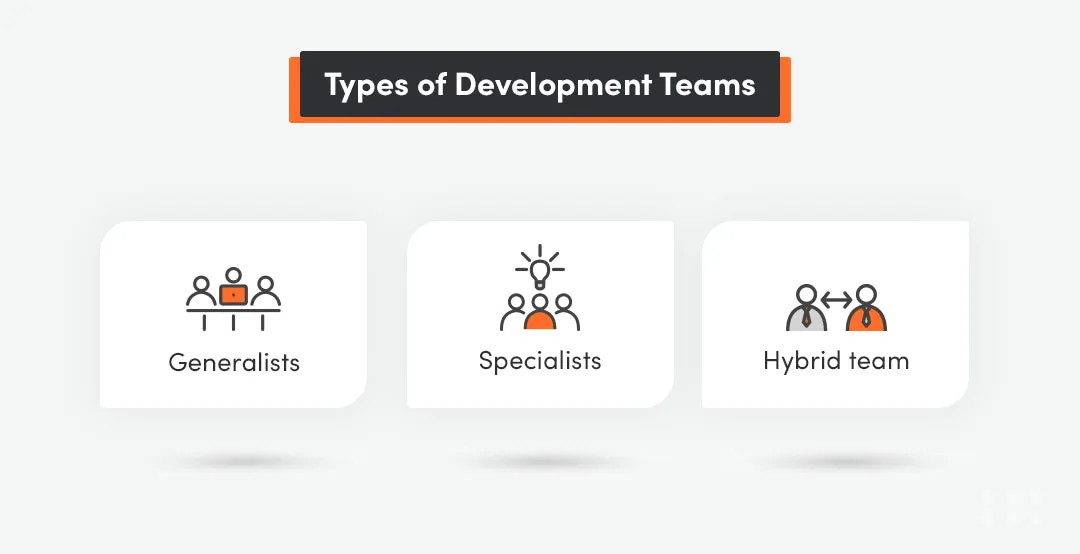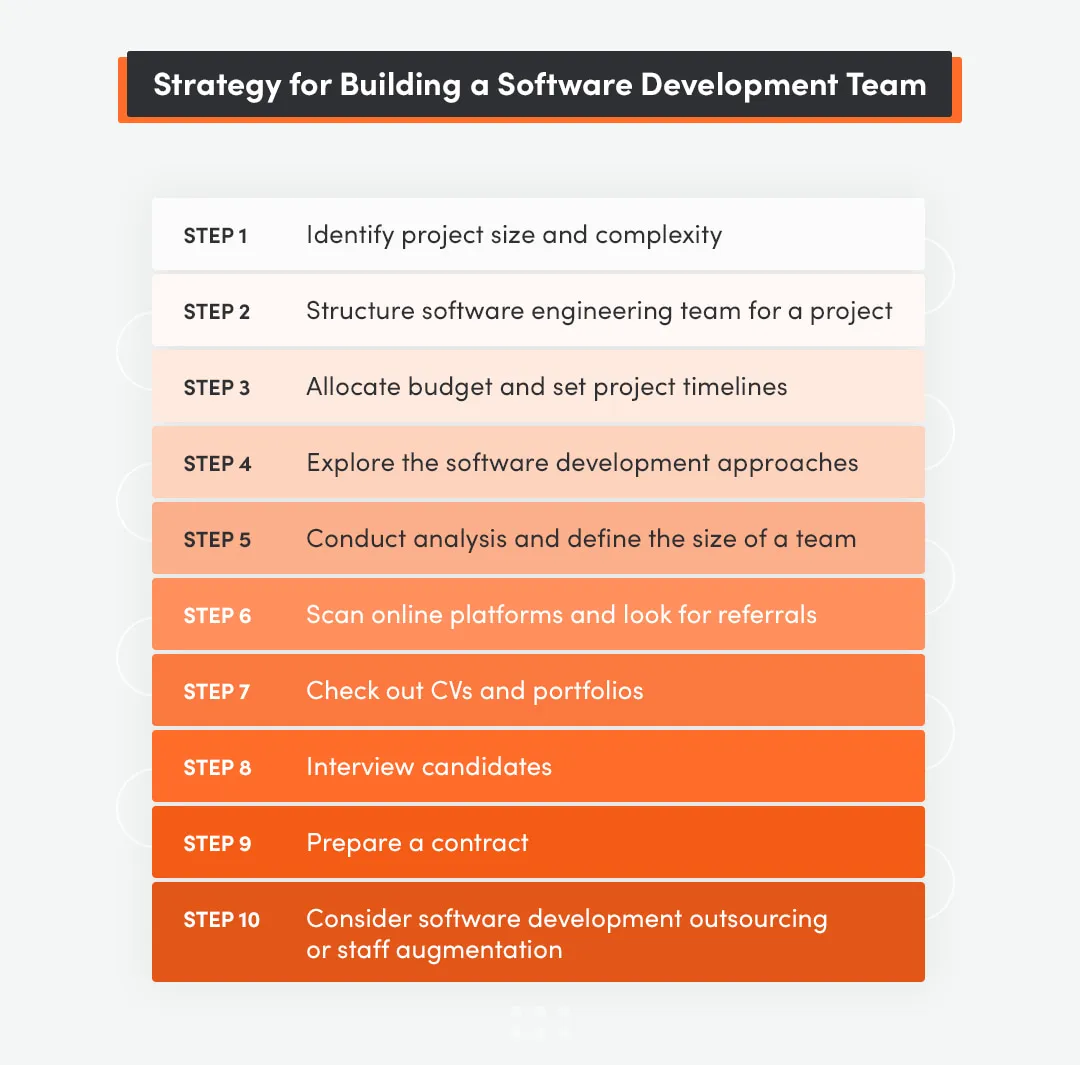Building a successful software development team involves strategic planning, navigating complicated systems, and uniting essential personnel who have a similar mindset toward attaining the shared objective. The software sector is growing multi-billion-dollar, with a 22% growth in employment for software developers from 2019 to 2029.
Dedicated software development teams have the skills, experience, and resources to create remarkable business solutions. A specialized dedicated development staff makes it simple to retain agility while minimizing costs. A successful software development team is completely focused on the project. They are not distracted by extra duties. Their undivided focus leads to increased productivity and faster project completion.
It is important to research the tips and positions that businesses will want to include in hiring plans to develop a successful software development team structure. Also, learn the startup team building secrets they don't want you to know
This article focuses on the key advantages organizations can gain by leveraging the knowledge of building software development teams for specific industries. It also includes the best strategies for building a software development team structure that will lead the product to success.
This article will explain the following sections in detail:
- The role of software engineers in a development team?
- How to build a software development team?
- Best strategies on how to build a software development team for Edtech, Fintech, Healthcare, and HRM.
- Role of Agile Methodology in building a software engineers team.
- Types of software engineering teams, their roles and responsibilities.
What Are 4 Things to Consider When Building a Software Development Team?
The following are the most important factors to consider, which will lead in the right direction when building a software development team.
Critical Thinkers
The purpose of building a successful software development team is to lead the project's success in the right direction, and there is a possibility that the software development team might not agree with early concepts. It indicates a willingness to seek out the best potential answer rather than simply following the instructions. Every member of the software development team should be a critical thinker.
Domain Expertise
Every software development project is a complicated process that entails more than just developing code. Look for professionals with established reputations who can bring their expertise when it counts the most.
Previous Projects
Prior projects completed by potential team members are an assessment of the standard of their work. You can observe what sort of clients they worked with and how they met the project criteria to address the provided challenge.
Sensible Pricing
Building a software development team can be more expensive than buying a ready-made solution available in the market. But sometimes inexpensive things lead to bad quality work.
With a dedicated software development team, a company can reap long-term benefits and flexibility. However, there should be proper marketing research to compare the cost of building a dedicated software development team, and pricing should be sensible.
How Do You Define the Type of Team That Will Fit Your Project or Structure?
An essential initial step in every project's overall success is establishing a well-defined software development team structure. A business owner has to understand the three primary types of development teams to make a well-informed selection. These software development teams can be divided into the following categories:

Generalists: Knowledge, soft skills, and expertise are widely held among generalists. A comprehensive solution to the problem can be offered by generalists, which is a benefit. They do, however, have certain disadvantages. For example, generalists may not have the knowledge and abilities necessary to complete a project that calls for a greater degree of experience in a certain field.
Specialists: Specialists have a distinct advantage in targeting a single issue with their knowledge and skill, resulting in more efficient and productive work. Because team members are often highly limited specialists, they may lack a general awareness of the tasks of other team members, making communication between them fairly unproductive.
Hybrid team: With the Hybrid team, the finest features of both approaches are combined: specialists concentrate on the functional aspects of software products, while generalists handle team collaboration and communication. However, there is a catch to this team vision. In terms of time and money, it is typically more challenging to assemble a team focused on software development.
Which software development team type suits your organization's structure depends on the initial outlining of the available position. The best option is to select a Hybrid team that can help in specialty and communication.
Try our developers.
Free for 2 weeks.
No risk. Just results. Get a feel for our process, speed, and quality — work with our developers for a trial sprint and see why global companies choose Selleo.
Benefits of Agile Software Development Teams

An experienced software development team that can take on any task, assignment, or deadline and achieve the seemingly impossible via methodical strategy, preparation, and execution is known as an agile team.
An agile team thoroughly understands the project, dissects it into manageable sections or modules, works on them alone or collaboratively across functional boundaries, tests, deploys, and finishes the project quickly.
91% of organizations state that adopting Agile is a strategic priority.
Within an agile team, almost all members have a common knowledge of the project's needs. This makes it possible for the team members to support one another in various situations.
The advantages of Agile provide managers with more control over their projects and make their jobs easier. Agile project management is distinctive because it prioritizes meeting project deadlines and providing customers with high-quality and valuable outcomes while adhering to project restrictions.
70% of agile organizations say that agile helps them achieve a faster time to market.
These are the top benefits of Agile, which is why top companies adopt this methodology for their software development process.
- High-quality product - Agile methodology in software development provides high-quality products because, in this method, testing is done at every phase, and no bug or error can remain in the final product. Agile ensures continuous improvement, self-organizing teams, and continuous improvement.
- Customer satisfaction - In the standard structure, the client is only involved in the planning phase and has no effect on implementation, which limits agility and adaptability.
- By engaging customers in the loop and making adjustments based on their feedback in Agile, you provide value to the customer and guarantee that the final product meets their expectations.
- Better control - Agile gives managers more control over the projects because of its openness, quality-control features, and feedback integration. Quality is maintained throughout the project's implementation phase. Furthermore, all stakeholders are informed with daily progress reports generated by innovative reporting tools and procedures.
- Reduced risks - Agile is implemented in small phases with an emphasis on continuous delivery. Even if a certain technique does not go as anticipated, there is always one small element that can be saved and used in the future.
- Increased flexibility - Agile provides project teams with unprecedented flexibility. Agile software development teams operate in shorter phases, complementing the stakeholders' continual feedback and engagement. On the other hand, changes in traditional project management approaches are typically time-consuming and costly.
- Continuous improvement - One of the 12 basic principles of the Agile manifesto is to work on self-reflection and continual improvement. The process is iterative, which implies that each Sprint will be better than the previous one and earlier errors will not be repeated.
- More relevant metrics - Agile methodology helps predict time and cost more precisely than a traditional method. It also helps to monitor project performance from start to end to deliver the best possible outcomes and optimize performance. At the same time, waterfall methods focus solely on the expected cost and time of project completion.
Agile, like any other project management style, is not flawless. The following are some of the most prevalent disadvantages of Agile Methodology:
- Less predictable,
- More time and commitment,
- Greater demands on developers and clients,
- Absence of the necessary documentation,
- Projects easily fall off track.
Software Development Team Roles and Responsibilities
In the software development process, each team member is given a distinct set of duties and responsibilities. The positions and duties that must be filled throughout the team's hiring process are listed below.
Project Manager
The primary responsibility of the Project Manager (PM) is to oversee the software project. They are in charge of understanding the "who, what, where, when, and why" of the software strategy and ensuring that project objectives are met.
They are also responsible for directing the software development team and communicating effectively with stakeholders.
MAIN RESPONSIBILITIES:
- Develop a project plan.
- Develop functional specifications.
- Planned, estimated, and managed resources and the project budget.
- Keep track of the project.
- Identify necessary adjustments to the plan.
- Provide regular updates to the senior management.
Business Analyst
The Business Analyst is responsible for converting business demands into requirements and ensuring they are accurately documented before developing and implementing a solution. This individual is an intermediary between the product owner and the developers, keeping track of the project's progress and conveying technical specifications.
MAIN RESPONSIBILITIES:
- Throughout the project, define, evaluate, and oversee the technical and business requirements.
- Support the client across the software development process by responding to inquiries, suggesting enhancements, outlining the project's scope, assigning priorities, and offering technical assistance.
- Make choices and direct the team during the software development as per previously established customer priorities.
- Conduct meetings with your software development team.
Team Lead
This job is typically filled by senior developers, architects, or lead testers with leadership experience to assist the team in staying focused on the tasks, completing work on schedule, and accomplishing project objectives.
In addition to making sure the software development team has all the tools necessary to finish the project and promptly handle any obstacles or problems that may come up, they assume the role of coach or mentor.
MAIN RESPONSIBILITIES:
- Lead the team's development to the successful completion of the project.
- Team members should get technical leadership from you through mentoring and coaching.
- Stop conflicts and find solutions to problems before they happen.
UX/UI Designer
UX/UI designers are in charge of creating user interfaces for any program or software product that is being created. They establish navigation paradigms, interaction sequences, visual information organization, and graphic style.
There are two kinds of designers, although there are often those who specialize in both areas:
UI Designer: UI Designers are responsible for the design of the user interface. This entails moving the text, style, and images that link a client or product to a system presentation layer.
UX Designer: UX Designers are in charge of ensuring that end users get the greatest experience possible when using an application. They examine user behavior as well as what the competition is doing.
MAIN RESPONSIBILITIES:
- Analyze the functional needs of users.
- Define the information architecture as well as the navigation model.
- Create prototypes for the proposal's validation throughout the design process.
- Take part in the development of web and desktop interfaces.
- Document every interface design decision.
Software Tester/QA Team
The QA Team is a group of software engineering professionals who help projects by ensuring that appropriate practices are followed during software development. Their goal is to assure quality at the process level in projects.
A Quality Assurance Lead can be assigned to the team and is responsible for building suitable relationships among QA team members, resolving disputes, and fostering excellent collaboration. There is also the QA Engineer, who is in charge of developing technologies that allow for the automation of operations that test software quality.
MAIN RESPONSIBILITIES:
- Analyze how well procedures are being followed and deliverables are being produced in accordance with the specified software process.
- Find and record any variations in the use of guidelines and protocols.
- To take remedial action and provide feedback about the outcomes of the quality assurance activities.
Scrum Master
One important part of the Agile process is the Scrum Master position. In addition to serving as a team facilitator, they are responsible for resolving any issues preventing the software development team from meeting its output targets. They are responsible for guaranteeing that team members stick to the Scrum method.
MAIN RESPONSIBILITIES:
- Serve as a facilitator for the development team to ensure that Agile ideals and methodology are followed.
- All Agile meetings must be led, planned, and followed up on.
- Teach the team all of the greatest Agile practices and principles.
- Serve as a go-between for the team and the Product Owner or any other outside participant.
- Follow up on team barriers and assist in removing them.
- Assist the product owner in keeping product backlogs up to date.
- Assist the team in focusing on the most important activities and results while minimizing unrelated disruptions and distractions.
What Is the Effective Strategy for Building a Software Development Team for Edtech, Fintech, HRM, and Healthcare?
When assembling a software development team, there are several factors that business owners must take into account, ranging from determining project resources to assessing the roles and duties you wish to assign to your software development team. These steps are as follows:

Step 1. Identify project size and complexity
First, determine the scope of the project before beginning to grasp how to assemble a software development team. Four specialists should be sufficient to construct a platform or develop a product prototype.
The opposite situation can occur if you create an application from the ground up with unique features and numerous third-party integrations - a greater need for experts. For a large-scale project's success, you might also need to put together many software engineering teams, each with a particular responsibility.
You may frequently need to draw on specialized experts for the project, for instance, programmers with expertise in desktop development, robotics, gaming development, AI, etc.
Therefore, to proceed without hiccups, it is better to address these points up front.
Step 2. Structure software engineering team for a project
The first step in learning how to put together a software development team should be to choose the best strategy for building a software development team. This is especially important if you have a software project that has to be completed with high quality. One of three groups is most often occupied by teams:
- Technology team (Specialists)
- Product team (Generalists)
- Matrix team (hybrid team)
The employees in these categories vary depending on their expertise, abilities, and job emphasis. It is crucial to comprehend their primary differences to anticipate potential problems when dealing with and overseeing them.
Step 3. Allocate budget and set project timelines
There is no one-size-fits-all method that works for every particular situation. Thus, the availability of project resources and the time frame are crucial factors to consider when assembling a software development team. The seniority of the specialists you may employ will be impacted by the financial resources at your disposal, in addition to the total number of team members.
It is best to analyze job estimation and carefully consider the software needs to prevent project blunders and maximize resources.
To guarantee cost flexibility without compromising quality, stick to Agile development and concentrate on high-priority features to save project expenditures.
Step 4. Explore the software development approaches
A productive software development team has several different responsibilities. The essential roles and makeup of the software engineering team will also vary depending on the project management style, whether Waterfall or Agile.
Read also: How To Build High-Performance Agile Teams
As we look at the table below, let's focus on the main distinctions between Agile and Waterfall teams.
Team size
- Agile team: 4 to 10 people per team
- Waterfall team: No team size limit
Team members
- Agile team: Team lead or tech lead, product owner or customer, PMs, BAs, developers, designers, testers, QAs, and other project stakeholders
- Waterfall team: Developers, testers, business analyst, and project development manager
Management approach
- Agile team: A self-managed and self-organized team where each team member is responsible for a specific task
- Waterfall team: Top-down management
Team synchronization
- Agile team: Small teams with a high degree of coordination
- Waterfall team: A lower degree of team synchronization due to vertical hierarchy
Customer involvement
- Agile team: Customers can participate throughout the project thanks to a transparent process.
- Waterfall team: Customers are involved during delivery presentations.
Project focus
- Agile team: A team focuses on one project
- Waterfall team: Several projects at a time
As you can see, the roles and responsibilities of Agile development teams are not the same as those of a classic Waterfall model.
Step 5. Conduct analysis and define the size of a team
It is essential to build a software development team with a clear understanding of each member's specialized responsibility. The size of a software development team and expectations for each team member can be determined once the nature, scope, resources, deadlines, and complexity of the project have all been thoroughly examined.
Step 6. Scan online platforms and look for referrals
Organizing your contact list is a good place to start if you're looking for tips on how to get software developers to join your team. This implies that you could already know someone in your sector who can suggest certain software developers or outsourcing businesses.
If not, you can search through specialized professional platforms to locate the ideal fit for your requirements. We suggest going to the following websites as samples of these:
- Clutch
- GoodFirms
- Upwork
- Glassdoor
Step 7. Check out CVs and portfolios
We find talent once we have drafted a precise job description with detailed specifications. When sourcing personnel, we consider a candidate's accomplishments, employment history, professed expertise, and employer recommendations.
The next crucial things to look for when choosing individuals are similar case studies and prior projects to see whether their experience matches our current demands.
Step 8. Interview candidates
During the interview, make sure to check the following points:
- Previous experience – to understand the candidate's expertise and ability to demonstrate their work and project deliverables
- Tech stack they're familiar with – to check if the candidate has practiced using the technologies and tools we expect from them (e.g., Figma, Jira, ClickUp, etc.)
- Attitude to work – find out their main motivations
- Collaboration skills – to understand the ability to communicate with team members, project stakeholders, and other teams and resolve possible misunderstandings
- Soft and hard skills – to verify if they match the expected ones
Through the interview, you can learn more about the candidate's work style, background, and prospective workflow. By conducting a proper hiring process, you can not only put together a software development team of the best potential but also create a welcoming work atmosphere and experience lower employee turnover.
Step 9. Prepare a contract
Before sending a job offer make sure to include the following legal aspects in cooperation agreements:
- Key goals, responsibilities, and tasks that you expect the candidate to perform. With this, you can ensure that the task will be finished as planned. If not, you will have a chance to utilize the legal recourse to demonstrate that the employee didn't fulfill their duty to complete the task.
- Conditions for terminating a contract: The organization will have full authority to terminate the contract or employment at any given period of time with prior notice.
After all the recruitment jobs are done, you can finally sort the list of candidates and choose one that suits your budget and project needs.
Step 10. Consider software development outsourcing or staff augmentation
Employing an effective software development team allows you to assign the complete execution of your software concept to a team of experts with a wealth of knowledge to produce outstanding solutions for your sector. This is the greatest choice for complex, long-term tasks.
Experts in software development can swiftly expand your engineering team to handle a fresh project, software upgrade, or redesigned application. In this arrangement, the vendor can help with organizational concerns, but you are in charge of administration.
Building a Software Development Team for Edtech, Fintech, HRM, and Healthcare - Key Differences
Experience and expertise in the relevant industry are crucial aspects of forming an effective software development team. Edtech, Fintech, HRM, and Healthcare are all top industries for software development demand, yet they are all quite diverse.

Here are a few considerations to think about while putting together an effective software development team for each of the sectors listed:
Edtech
Edtech is concerned with the education business, and the most prevalent type of software used in education is Learning Management Systems. The primary goal of a learning management system (LMS) is to enable accessibility and connection between educational institutions and students. The initial components of a customized EduTech solution are design and user experience.
The Edtech software development team should be well-versed in design and user experience. The developers should have good knowledge of creating simple navigation to enhance user experience. They should also be able to create an LMS that can be integrated with other systems and software.
One of the key differences is that the Edtech software development team should be more expert in mobile apps as most people will use it on mobile with ease.
The education industry is also regulated by some of the laws, which are listed below:
- The European Economic Area's General Data Protection Regulation (GDPR)
- Family Educational Rights and Privacy Act (FERPA)
- The Personal Information Protection and Electronic Documents Act (PIPEDA)
- The Personal Data Protection Bill (PDPB)
- The Personal Data Protection Act (PDPA)
Fintech
The security and privacy of consumer data are two of the main issues while creating Fintech solutions. Fintech businesses and their clients may lose millions, if not billions, of dollars due to a minor leak. Compliance is another crucial element that needs to be considered from the very beginning of the development planning process.
The laws and regulations that govern the fintech sector are heavily regulated and subject to frequent changes, given that a Fintech company cannot rely on a pre-made solution. Building a successful software development team is important for financial institutes.
Industry expertise is one of the most important factors for fintech sector developers. Developers might be unable to adhere to these laws if they are ignorant of GDPR or anti-money laundering legislation.
Here is a summary of some of the most significant laws governing the fintech sector that are common to practically all nations.
- Fair Credit Reporting Act (FCRA)
- General Data Protection Regulation (GDPR)
- Anti-money laundering regulations (AML)
- Electronic Fund Transfer Act (EFTA)
- Securities and Exchange Commission (SEC)
A fintech developer must possess the expertise to create high-level security protocols and encryption with Fintech solutions.
HRM
The Human Resource Management software's main objective is to integrate with all other organizational departments. You must consider several variables, such as functionality, security, and implementation while developing an effective system. Everyone should be able to utilize the system more easily due to its design.
One of the major key differences in building a successful development team for HRM solutions compared to any other industry is integration. The developer should have complete knowledge of protocols, gateways, and tech stack to build a solution that can easily integrate with any financial solution, LMS, or database system.
It should also know how to build a system that is easy to use. Mobile app development skills are also one of the key components for the HRM development team.
Healthcare
Medical records, test results, medications, and personal information about patients are kept under complete confidentiality. Thus, when patient data is collected via healthcare apps, security assurance will be given top attention. So, to ensure security, healthcare software solution vendors need to meet the standards set out by government medical authorities.
Below are some of the aspects that one should check in the app:
- Confidentiality: Ensure that all the information entered by the patient is confidential.
- Usability: Ensure that the user is happy with the interface.
- Compatibility: Ensure the app works fine on all platforms like iOS, Android, etc.
Some of the most important standards and recommended guidelines to be followed are:
- ISO 13485 – Medical devices – Quality management system,
- IEC 62304 – Medical device software – Software life cycle processes,
- ISO TS 25238 Health informatics – Classification of safety risks from health software,
- ISO 14971 – Medical devices — Application of risk management to medical devices,
- IEC 62366 – Medical devices — Application of usability engineering to medical devices,
- IEC 60601 – Medical electrical equipment – Safety and essential performance of medical electrical equipment.
A Healthcare solution development team should have prior experience creating similar software to showcase their knowledge about industry rules and regulations. Knowledge and expertise are both equally important for the healthcare software development team.
Project Manager or Scrum Master in Software Development Team - What Is Better?
Project managers and scrum masters are not the same. A project manager is a professional who oversees almost any kind of project, whereas a scrum master is a function that is particularly fixed on a scrum team.
Not only does a project development manager oversee the logistical components, such as budgets, timelines, and communication plans, but they also keep their team motivated and on track. A Scrum Master's main responsibility is to guide a team in sticking to Scrum principles.
Here are the main differences between Scrum Masters and project managers:
Only Scrum projects and Scrum teams are allowed to have Scrum Masters. Any project, including Agile and Waterfall projects, can be managed by a project manager.
Scrum Masters are responsible for ensuring the success of a project team. In contrast, project managers are often in charge of the day-to-day operations of a project, including risk assessment and budgeting.
The role of a Scrum Master is to lead teams through sequential project increments to achieve a successful end. Meanwhile, the role of a project manager might be to oversee all of the logistical aspects of a project, from planning and implementation to completion.
Case Studies
Project Management: The Airbus A380 Project is a project management case study that demonstrates the difficulties experienced when developing and manufacturing the world's biggest commercial aircraft. With many challenges emerging from the production and delivery process, outsourcing, and project coordination, the project encountered major delays and affected costs of more than $6 billion.
The Airbus A380, on the other hand, was launched successfully due to well-planned project management procedures, resulting in a world-class aircraft that exceeded customer expectations.
Scrum Master: Philips is a leader in health technology that has utilized Scrum and freeing frameworks to assist people in handling obstacles ranging from minor to major by efficiently working together. This case study shows how Scrum Teams (can) employ Liberating Structures to provide additional value to their stakeholders.
Scrum Master helps build understanding between scrum teams and management with a liberating structure.
If the project needs cross-communication and complete monitoring from level 0 to the completion phase, then the Project Manager is the right option. However, if a project has tight deadlines and needs flexibility in the development process, then a Scrum master is what the project needs.
Summary
Putting up an effective software development team is more important than ever due to the constantly modernizing requirements of software and product development.
Whether it should be made up of specialists with an in-depth understanding of their field, a flexible group of generalists with some knowledge of other areas, or a combination of the two, next, you must decide on your team's size while considering the implications of your decision.
But keep in mind that a productive team has established open lines of communication and a realistic work environment.
By following the aforementioned methods and working with a properly selected team of technical experts for software development, you can accelerate projects and increase productivity.





